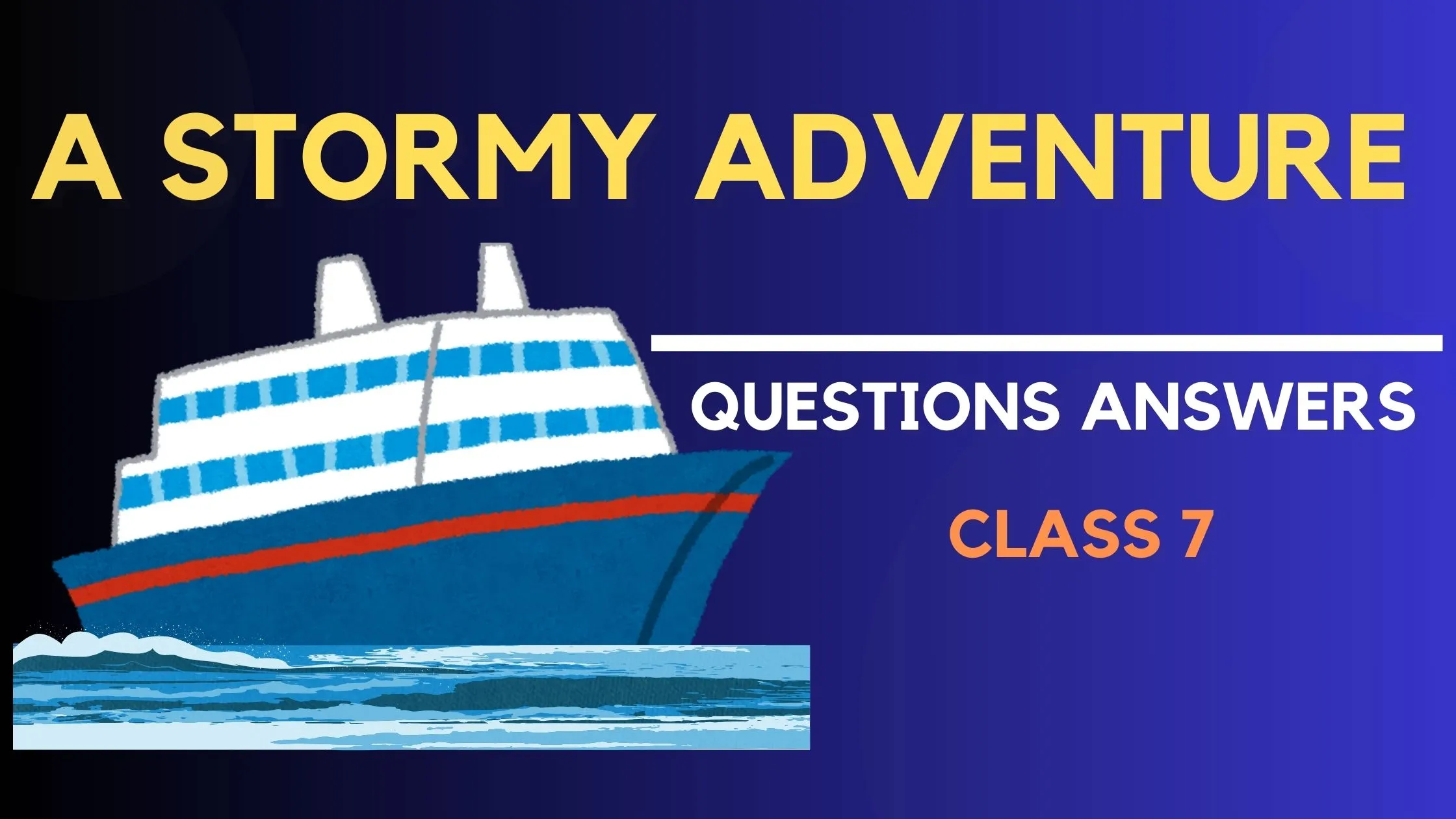A Stormy Adventure Class 7 Questions Answers for DAV l: Explore the thrilling story of A Stormy Adventure with detailed questions and answers designed for DAV Class 7 students. Enhance your understanding with clear explanations and insightful answers. Perfect for exam preparation and mastering the story!
A Stormy Adventure Class 7 Textual Questions Answers
Get detailed A Stormy Adventure Class 7 textual questions and answers for easy understanding and exam preparation.
I Understanding the Story
A. Complete the following statements by filling in the blanks with one word only.
1. The name of the Captain of the Trishna was Kumar.
2. The Trishna weighed 8000 tons.
3. Mr. Bose held the post of Chief Engineer on the Trishna.
4. The boating incident, where the boat that Vishal and his friends were traveling in developed a leak, happened in Okhla.
B. Answer the following questions in not more than 50 words.
1. Meanings of the following words:
- Solitary: Alone or without companions.
- Lurch: A sudden, uncontrolled movement.
- Sea-legs: The ability to walk steadily on a moving ship.
- Gangway: A narrow passage that people use to get on or off a ship.
2. “She groaned and held her stomach.” Why was Rohini groaning?
Ans: Rohini was groaning because she felt seasick due to the constant rocking motion of the ship. The stormy weather and rough waves made the ship unstable, which caused her to feel uneasy and uncomfortable, leading to her groaning in pain.
Ans: Here are some sea-related words:
- Waves
- Ship
- Storm
- Tide
- Horizon
- Sailor
- Seagulls
4. What thought came to your mind at first after listening to the title “A Stormy Adventure”?
Ans: The first thought that comes to mind is that the story would involve a thrilling and dangerous journey at sea, where the characters face challenges from a fierce storm, testing their courage and survival skills.
5. Write four adjectives to describe the character of Vishal.
- Brave
- Quick-thinking
- Resourceful
- Adventurous
6. “Perhaps that saved us.” How were they saved?
Ans: They were saved when Vishal remembered a similar situation from his past and suggested blocking the leaks with mattresses. The crew quickly followed his advice, and the water was stopped from entering the ship. This quick action helped stabilize the ship, allowing them to survive the storm.
7. Do you think Vishal was a hero? Justify your answer.
Ans: Yes, Vishal can be considered a hero. Despite being young, he stayed calm and used his quick thinking to suggest a plan that saved the ship and everyone on board. His bravery and resourcefulness in a difficult situation were heroic qualities.
8. Imagine you are Rohini Vishal. Write a message to your mother to inform her about your delay to return home due to the turbulent situation at sea.
Ans:
Dear Mom,
We are fine, but there was a big storm at sea, and we had some scary moments. The ship rocked a lot, but we are safe now. We’ll be delayed in returning home because the storm slowed us down. Please don’t worry, we’ll see you soon.
Love, Rohin
9. Imagine that you are Vishal. Write a diary entry about your feelings after controlling the turmoil situation on the sea.
Diary Entry:
Ans: Today was one of the most terrifying days of my life! The storm hit us so hard, and I could feel the fear in everyone. Rohini was seasick, and I was really worried, but then I remembered a similar situation from the past. My suggestion to block the leaks with mattresses worked! The crew quickly took action, and we were saved. I feel proud but also thankful that we made it through safely. It was a real adventure, but one that I hope I don’t have to repeat anytime soon!
10. Narrate an adventurous journey of your life where you faced difficult challenges. What have you learned from it?
Ans: One of my most adventurous journeys was during a mountain trek. We were hiking when a sudden storm hit us. The rain was heavy, and the path became slippery and dangerous. We had to work together to stay safe, using ropes and helping each other through the difficult parts of the trail. I learned that staying calm and trusting each other in challenging times is important. The experience taught me the value of teamwork, patience, and resilience, and it’s something I will never forget.
11. Who was Captain Kumar? Why was he worried?
Ans: Captain Kumar was the captain of the ship M.V. Trishna. He was worried because the ship encountered a violent storm while sailing, and the weather was getting worse. Strong winds and rough seas were causing damage to the ship, and water had started leaking inside, putting everyone’s life in danger.
12. How was the Trishna saved?
Ans: The Trishna was saved when Vishal suggested tilting the ship to one side to prevent more water from entering through the hole. This idea, combined with the crew’s quick actions to lash the cargo and block the leak, helped balance the ship and kept it from sinking during the storm. This saved everyone onboard.
13. Where was the Trishna going? Why was it going there?
Ans: The Trishna was heading to the Philippines on a research mission. The ship’s crew and scientists onboard were going there to conduct oceanographic studies, collecting data about sea currents and marine life. This journey was an important part of their scientific expedition.
14. ‘Now indeed, it would be smooth sailing!’ – Why had it been said so?
Ans: This statement was made after the storm had passed and the Trishna was no longer in danger. The crew successfully stopped the water from leaking, and the ship was steady once again. Since the worst part of the journey, the storm, was over, everyone believed the rest of the voyage would go smoothly without any further troubles.
15. What incident happened with Vishal and his friends in Okhla?
Ans: In Okhla, Vishal and his friends experienced a dangerous boating incident. While they were enjoying their ride, their boat developed a leak and began to sink. Luckily, they managed to stay calm and escape safely. This incident taught Vishal how to handle similar situations, which later helped him during the storm on the Trishna.
16. Where was the Trishna going? Why was it going there?
Ans: The Trishna was going to the Philippines, carrying food supplies to the small islands in the South China Sea, where a devastating typhoon had struck. The people in these islands were starving and in desperate need of relief.
17. Why was Captain Kumar worried?
Ans: Captain Kumar was worried because the barometer showed a steep drop, indicating a typhoon was approaching. The weather reports confirmed that Typhoon Elsie was moving closer, and he was concerned about the ship’s safety and the urgent need to deliver food supplies.
18. What was the effect of bad weather on the Trishna?
Ans: The bad weather caused the Trishna to roll and pitch violently, leading to damage on board. Some of the cargo was damaged, water gushed into the Engine Room, and there was a risk of the ship capsizing due to the storm’s severity.
19. What suggestion did Vishal have to offer to his father?
Ans: Vishal suggested that the ship be listed to one side to expose the hole in the ship’s side, similar to how they handled a leak in a boat during an earlier incident. This could help the crew block the hole and stop the water from flooding the Engine Room.
20. How was the Trishna saved?
Ans: The Trishna was saved by following Vishal’s suggestion to list the ship, exposing the hole. The crew managed to block the leak with a wooden plug and cement. Pumps were then used to drain the water from the Engine Room, and the ship regained stability.
Or
The Trishna was saved when Vishal suggested tilting the ship to expose the hole on its side, which was allowing water to enter the engine room. Following his idea, the crew tilted the ship, and the Chief Officer and his men used a wooden plug and cement to block the hole, stopping the water from flooding the ship.
21. What does the title “A Stormy Adventure” suggest about the story?
Ans: The title “A Stormy Adventure” suggests that the story is about a thrilling and dangerous experience at sea, where the characters face a powerful storm, endure challenges, and ultimately overcome the dangers, making it a memorable and adventurous journey.
C. In the story ‘A Stormy Adventure’, some situations and actions lead to certain results. Complete the table given below by writing in appropriate columns the action or the result that the given situations produced.
| Action | Result |
| 1. Rohini felt seasick. | She remained in bed and took seasickness pills. |
| 2. Capt. Kumar ordered the men on the deck to lash the cargo. | The cargo was secured for the incoming typhoon. |
| 3. Water gushed into the Trishna. | The Engine Room started flooding. |
| 4. Vishal remembered a similar boat incident. | He suggested listing the ship to expose the hole. |
| 5. The Trishna was saved. | The leak was blocked, and the water was drained. |
II. A Stormy Adventure Class 7 HOTS (Higher Order Thinking Skills)
Do you think it was easy for Captain Kumar to accept the risky suggestion given by Vishal? What might be going on in his mind? Why do you think he finally accepted the suggestion?
Ans: It was not easy for Captain Kumar to accept Vishal’s suggestion because it was risky to list the ship during such stormy weather. He must have been worried about further damage or capsizing. However, Captain Kumar trusted Vishal’s logical reasoning and saw it as the only solution to save the ship. The urgency of the situation and the need to prevent the ship from sinking ultimately made him accept the idea.
III. A Stormy Adventure Class 7 Life Skills
You’re quite a seaman really… says the Chief Officer about Vishal. Would you call Vishal a seaman? Give reasons.
Ans: Yes, Vishal can be called a seaman because he remained calm and observant during the storm, showing qualities of a seaman. He was attentive to his father’s concerns, understood the situation, and offered a practical solution that helped save the ship. Despite his initial nervousness, Vishal acted bravely and intelligently, contributing to the safety of everyone on board.
IV. A Stormy Adventure Class 7 Values
Imagine that the ship you are traveling in gets caught in bad weather. How would you react? Would you be frightened, anxious, or excited? How could you be of help to others in such a situation?
Ans: If I were caught in bad weather on a ship, I would likely feel a mixture of fear and anxiety, but I would try to remain calm. In such a situation, I could help others by staying composed, following safety instructions, and assisting those who are panicking or in need of help. Keeping a clear mind would allow me to be of support to the crew and fellow passengers.
A Stormy Adventure Class 7 Writing Skills
Imagine yourself to be Vishal. Write an article for the school magazine describing your adventurous journey.
My Adventurous Journey on M.V. Trishna
By Vishal
This summer, I had the most thrilling experience of my life while sailing on the M.V. Trishna with my father, Captain Kumar. We were heading to the Philippines to deliver food supplies when a powerful typhoon hit us. The sea was wild, with enormous waves crashing against the ship.
At one point, water started flooding the engine room due to a leak. It seemed like we might not make it. But I remembered a boating trick from my past and suggested tilting the ship to plug the hole. My father took the risk, and it worked! We managed to save the ship.
It was a scary but unforgettable adventure, and I’ll always remember it as my stormy adventure at sea!
Imagine yourself to be Vishal. Write a letter to your cousin describing your adventurous journey in M.V. Trishna.
Dear Cousin,
I hope you’re doing well. I have to tell you about the most thrilling adventure I had on the ship M.V. Trishna. We were sailing to the Philippines, and everything was going fine until a massive typhoon hit us. The ship was tossed around by huge waves, and the wind was terrifying! At one point, water started leaking into the engine room, and we thought the ship might sink.
I remembered a trick from a past boating experience and suggested tilting the ship to block the leak. Thankfully, it worked, and we were saved! It was scary but exciting at the same time. Now, we’re back on course, and everything is fine.
Hope to see you soon!
Yours, Vishal
A Stormy Adventure Class 7 Extract-Based MCQ
Explore A Stormy Adventure Class 7 extract-based MCQs to enhance your comprehension and ace your exams with confidence.
A Stormy Adventure Class 7 Extract 1:
“The M.V. Trishna gave a gentle lurch. ‘Not seasick again!’ exclaimed Vishal, looking at his younger sister Rohini in deep disgust, as she groaned and held her stomach.”
1. What does the phrase “gentle lurch” suggest about the movement of the ship?
a) The ship was completely still
b) The ship moved smoothly
c) The ship moved slightly
d) The ship stopped abruptly
Answer: c) The ship moved slightly
2. Why did Vishal feel disgusted?
a) Because the ship was tilting
b) Because Rohini was seasick again
c) Because the cargo was damaged
d) Because the weather was bad
Answer: b) Because Rohini was seasick again
3. What did Rohini do when she felt seasick?
a) She complained loudly
b) She groaned and held her stomach
c) She ran to the deck
d) She fell asleep immediately
Answer: b) She groaned and held her stomach
4. How did Vishal express his emotions towards Rohini’s seasickness?
a) He laughed at her
b) He ignored her
c) He showed disgust
d) He comforted her
Answer: c) He showed disgust
5. What does Vishal imply when he says, “Can’t imagine why you came along at all!”?
a) He thought the trip would be boring
b) He thought Rohini shouldn’t have come if she got seasick easily
c) He didn’t want her to come
d) He was worried about the ship
Answer: b) He thought Rohini shouldn’t have come if she got seasick easily
Extract 2:
“The Trishna was on her way to the Philippines. The ship was carrying a special cargo of food for the people of the small islands in the South China Sea, which had been struck by a devastating typhoon.”
1. Where was the M.V. Trishna heading?
a) Japan
b) The Philippines
c) South America
d) India
Answer: b) The Philippines
2. What was the purpose of the Trishna’s journey?
a) To rescue people from the sea
b) To deliver food to typhoon-affected islands
c) To pick up passengers
d) To provide medical aid
Answer: b) To deliver food to typhoon-affected islands
3. What natural disaster had affected the small islands in the South China Sea?
a) Earthquake
b) Tsunami
c) Typhoon
d) Volcano
Answer: c) Typhoon
4. What kind of cargo was the Trishna carrying?
a) Machinery
b) Food supplies
c) Electronics
d) Clothing
Answer: b) Food supplies
5. What can be inferred about the condition of the islands?
a) They were preparing for a festival
b) They had been severely damaged by the typhoon
c) They were facing political issues
d) They were receiving help from other countries
Answer: b) They had been severely damaged by the typhoon
Extract 3:
“Capt. Kumar had a worried look on his face. He was staring restlessly at the barometer which had fallen steeply.”
1. Why was Capt. Kumar worried?
a) The barometer had fallen steeply
b) The ship was off course
c) There was no communication
d) The cargo was lost
Answer: a) The barometer had fallen steeply
2. What does a steep fall in the barometer indicate?
a) Calm weather
b) Rough weather ahead
c) The ship was slowing down
d) A mechanical problem
Answer: b) Rough weather ahead
3. How did Capt. Kumar react to the barometer reading?
a) He was calm and composed
b) He became restless and worried
c) He dismissed it as a normal occurrence
d) He ignored it completely
Answer: b) He became restless and worried
4. What does the word “restlessly” suggest about Capt. Kumar’s state of mind?
a) He was relaxed
b) He was uncomfortable and anxious
c) He was excited
d) He was disinterested
Answer: b) He was uncomfortable and anxious
5. What does the barometer measure?
a) Wind speed
b) Humidity
c) Air pressure
d) Temperature
Answer: c) Air pressure
Extract 4:
“Typhoon Elsie is deepening in the Pacific Ocean and moving slowly in a north-westerly direction.”
1. Where was Typhoon Elsie forming?
a) In the South China Sea
b) In the Atlantic Ocean
c) In the Pacific Ocean
d) In the Mediterranean Sea
Answer: c) In the Pacific Ocean
2. What does “deepening” mean in the context of the typhoon?
a) The typhoon is weakening
b) The typhoon is getting stronger
c) The typhoon is changing direction
d) The typhoon is slowing down
Answer: b) The typhoon is getting stronger
3. In which direction was Typhoon Elsie moving?
a) North
b) South-west
c) North-west
d) East
Answer: c) North-west
4. What was the predicted impact of the typhoon on the ship?
a) It would pass too close to the ship
b) It would miss the ship entirely
c) It would push the ship towards land
d) It would damage the ship’s engines
Answer: a) It would pass too close to the ship
5. What was the significance of Typhoon Elsie’s direction for Capt. Kumar?
a) He knew the ship would sink
b) He wanted to change course to avoid it
c) He wasn’t concerned at all
d) He planned to sail straight into it
Answer: b) He wanted to change course to avoid it
Extract 5:
“By the afternoon, the wind had whipped up to a speed of 65 knots an hour. The sky grew dark with menacing clouds.”
1. How fast was the wind blowing?
a) 50 knots per hour
b) 65 knots per hour
c) 80 knots per hour
d) 100 knots per hour
Answer: b) 65 knots per hour
2. What does the word “whipped” suggest about the wind?
a) It was blowing gently
b) It was blowing fiercely
c) It was blowing steadily
d) It had stopped completely
Answer: b) It was blowing fiercely
3. What was the sky filled with?
a) Clear blue clouds
b) Light, fluffy clouds
c) Dark, menacing clouds
d) Storm clouds
Answer: c) Dark, menacing clouds
4. What effect did the increasing wind have on the sea?
a) The sea became calm
b) The waves grew fiercer
c) The sea froze
d) The sea remained unchanged
Answer: b) The waves grew fiercer
5. What could be inferred about the weather by the afternoon?
a) The weather was improving
b) A storm was approaching
c) The weather remained calm
d) The storm had passed
Answer: b) A storm was approaching
Extract 6:
“‘All hands on deck!’ came the urgent command. The crew scrambled to secure the cargo and check the ship’s sails.”
1. What does “All hands on deck” mean?
a) Everyone must leave the ship
b) Everyone must help on the deck
c) Everyone should go to sleep
d) Everyone should stay indoors
Answer: b) Everyone must help on the deck
2. Why did the crew scramble to secure the cargo?
a) The cargo was falling off
b) They were preparing for rough weather
c) The cargo was being stolen
d) The ship was sinking
Answer: b) They were preparing for rough weather
3. What does the word “scrambled” suggest about the crew’s actions?
a) They were moving quickly and in a rush
b) They were relaxing
c) They were moving slowly
d) They were disorganized
Answer: a) They were moving quickly and in a rush
4. What did the crew check apart from securing the cargo?
a) The engines
b) The sails
c) The cabins
d) The lifeboats
Answer: b) The sails
5. Why was there an “urgent command”?
a) The ship was in immediate danger
b) The ship was nearing its destination
c) The ship was running late
d) The weather was improving
Answer: a) The ship was in immediate danger
Extract 7:
“Rohini’s heart was pounding. The wind howled like a thousand wild animals. ‘Hold on!’ shouted Vishal, grabbing her arm as the ship pitched violently.”
1. What caused Rohini’s heart to pound?
a) Excitement
b) Fear from the storm
c) Happiness
d) Anger
Answer: b) Fear from the storm
2. What literary device is used in “The wind howled like a thousand wild animals”?
a) Simile
b) Metaphor
c) Hyperbole
d) Personification
Answer: a) Simile
3. Why did Vishal grab Rohini’s arm?
a) To comfort her
b) To keep her from falling
c) To tell her a secret
d) To help her climb
Answer: b) To keep her from falling
4. How was the ship behaving during the storm?
a) It was sinking slowly
b) It was moving calmly
c) It was pitching violently
d) It was at a standstill
Answer: c) It was pitching violently
5. What does the phrase “Hold on!” imply?
a) They were about to abandon the ship
b) Vishal was asking Rohini to remain calm and steady
c) Vishal was telling Rohini to run away
d) They were about to disembark
Answer: b) Vishal was asking Rohini to remain calm and steady
Extract 8:
“The rain pelted down in sheets, drenching the deck, while lightning split the sky with blinding flashes.”
1. How did the rain fall?
a) In a drizzle
b) In heavy sheets
c) As light drops
d) As snowflakes
Answer: b) In heavy sheets
2. What does “pelted” suggest about the rain?
a) It was falling gently
b) It was falling heavily and forcefully
c) It was not raining at all
d) It was snowing instead
Answer: b) It was falling heavily and forcefully
3. What effect did the rain have on the ship’s deck?
a) It cleaned the deck
b) It drenched the deck completely
c) It made the deck slippery
d) It had no effect on the deck
Answer: b) It drenched the deck completely
4. What natural phenomenon accompanied the rain?
a) A rainbow
b) Lightning
c) Sunshine
d) Hailstorm
Answer: b) Lightning
5. What does “lightning split the sky” mean?
a) The sky was clear
b) The lightning was strong and bright
c) The sky was breaking apart
d) The ship was hit by lightning
Answer: b) The lightning was strong and bright
Extract 9:
“Amid the chaos, Capt. Kumar’s voice remained calm as he gave instructions to his crew over the intercom.”
1. How did Capt. Kumar react to the chaotic situation?
a) He panicked
b) He stayed calm
c) He ignored the situation
d) He shouted at the crew
Answer: b) He stayed calm
2. What tool did Capt. Kumar use to communicate with his crew?
a) A loudspeaker
b) The intercom
c) A megaphone
d) A whistle
Answer: b) The intercom
3. What does “amid the chaos” imply?
a) There was complete peace on the ship
b) There was a lot of disorder and confusion
c) The ship was calm
d) The crew was relaxing
Answer: b) There was a lot of disorder and confusion
4. Why was Capt. Kumar giving instructions to the crew?
a) To ensure the safety of the ship
b) To ask them to relax
c) To prepare them for docking
d) To ignore the storm
Answer: a) To ensure the safety of the ship
5. What does Capt. Kumar’s calmness suggest about his leadership?
a) He was inexperienced
b) He was confident and composed under pressure
c) He was scared but hiding it
d) He didn’t care about the crew
Answer: b) He was confident and composed under pressure
Extract 10:
“As the storm raged on, the ship fought bravely, slicing through the giant waves. Rohini clung to Vishal, her knuckles white with fear.”
1. What does “the ship fought bravely” imply?
a) The ship was unaffected by the storm
b) The ship was struggling but enduring the storm
c) The ship was sinking
d) The ship was moving smoothly
Answer: b) The ship was struggling but enduring the storm
2. How did Rohini feel during the storm?
a) Calm and peaceful
b) Excited and curious
c) Terrified and anxious
d) Angry and annoyed
Answer: c) Terrified and anxious
3. What does “her knuckles white with fear” suggest about Rohini?
a) She was feeling brave
b) She was gripping tightly out of fear
c) She was feeling relaxed
d) She was calm
Answer: b) She was gripping tightly out of fear
4. Who did Rohini cling to during the storm?
a) Capt. Kumar
b) The ship’s crew
c) Vishal
d) Herself
Answer: c) Vishal
5. What natural event was occurring as Rohini clung to her brother?
a) A typhoon
b) A tornado
c) A rainstorm
d) A calm breeze
Answer: a) A typhoon
A Stormy Adventure Class 7 Extract-Based Questions Answers
Find comprehensive A Stormy Adventure Class 7 extract-based questions and answers to boost your understanding and exam readiness.
A Stormy Adventure Class 7 Extract 1:
“The Trishna was an 8000-ton ship that Vishal’s father, Captain Kumar, was commanding. It was headed to the Philippines, carrying food supplies for the islands hit by a terrible typhoon.”
1. Who was commanding the Trishna?
Answer: Captain Kumar, Vishal’s father, was commanding the Trishna.
2. What was the weight of the ship?
Answer: The Trishna weighed 8000 tons.
3. Where was the ship going?
Answer: The Trishna was going to the Philippines.
4. What was the ship carrying?
Answer: The ship was carrying food supplies.
5. Why were the supplies needed in the Philippines?
Answer: The supplies were needed because the islands in the Philippines were hit by a terrible typhoon.
Extract 2:
“Vishal and his sister Rohini were thrilled to be on board the ship. It was their first long sea voyage, and they were excited about the adventure that lay ahead.”
1. Who were Vishal and Rohini?
Answer: Vishal and Rohini were siblings, and Vishal was the son of Captain Kumar.
2. How did Vishal and Rohini feel about the journey?
Answer: They were thrilled and excited about the adventure.
3. Why were they excited?
Answer: It was their first long sea voyage.
4. What kind of journey did they expect?
Answer: They expected an adventurous journey.
5. Who else was on board with Vishal and Rohini?
Answer: Their father, Captain Kumar, was also on board as the captain of the ship.
Extract 3:
“The weather reports predicted rough weather ahead. Captain Kumar looked worried as the barometer dropped sharply, indicating an approaching storm.”
What did the weather reports predict?
Answer: The weather reports predicted rough weather ahead.
1. Who looked worried?
Answer: Captain Kumar looked worried.
2. Why was Captain Kumar worried?
Answer: He was worried because the barometer dropped sharply, indicating an approaching storm.
3. What does the barometer indicate?
Answer: The barometer indicates changes in weather, and a sharp drop means a storm is coming.
4. What storm was approaching?
Answer: A typhoon was approaching, later identified as Typhoon Elsie.
Extract 4:
“The Trishna rolled and pitched violently as the storm struck. Waves as high as 40 feet crashed against the ship, and water began to leak into the Engine Room.”
1. What happened when the storm struck?
Answer: The Trishna rolled and pitched violently, and waves crashed against the ship.
2. How high were the waves?
Answer: The waves were as high as 40 feet.
3. Where did water begin to leak into?
Answer: Water began to leak into the Engine Room.
4. What effect did the storm have on the Trishna?
Answer: The storm caused the ship to rock violently, and water started flooding parts of the ship.
5. What is likely to happen if water floods the Engine Room?
Answer: If water floods the Engine Room, it could cause the ship to lose control and possibly sink.
Extract 5:
“Rohini felt seasick because of the constant motion of the ship. She stayed in her cabin, trying to rest, but the rough sea made her feel worse.”
1. Why did Rohini feel sick?
Answer: Rohini felt seasick due to the constant motion of the ship.
2. Where did Rohini stay?
Answer: Rohini stayed in her cabin.
3. What did Rohini do to feel better?
Answer: She tried to rest in her cabin.
4. Did resting help Rohini feel better?
Answer: No, the rough sea made her feel worse.
5. What is seasickness caused by?
Answer: Seasickness is caused by the motion of the ship, which affects a person’s sense of balance.
Extract 6:
“Vishal remembered a similar boating incident when he and his friends were caught in a storm. Their boat had developed a leak, but they managed to plug it and get back to shore.”
1. What did Vishal remember?
Answer: Vishal remembered a boating incident when their boat developed a leak during a storm.
2. What happened to Vishal’s boat in the past?
Answer: The boat developed a leak during a storm.
3. How did they save the boat in that incident?
Answer: They managed to plug the leak and return to shore safely.
4. What lesson did Vishal learn from that experience?
Answer: Vishal learned that plugging the leak could save a boat in a storm.
5. How did this memory help Vishal during the storm on the Trishna?
Answer: This memory gave Vishal an idea to suggest a way to save the Trishna by listing the ship to expose the hole and plug the leak.
Extract 7:
“‘We can list the ship to one side and expose the hole,’ Vishal suggested to his father. His father hesitated, but then agreed it was the best option.”
1. What suggestion did Vishal give to his father?
Answer: Vishal suggested listing the ship to one side to expose the hole.
2. Who did Vishal give the suggestion to?
Answer: Vishal gave the suggestion to his father, Captain Kumar.
3. Why did his father hesitate?
Answer: His father hesitated because it was a risky move during a storm.
4. Why did Captain Kumar finally agree to the suggestion?
Answer: Captain Kumar agreed because it was the best option to save the ship.
5. What would listing the ship achieve?
Answer: Listing the ship would expose the hole and allow the crew to block it.
A Stormy Adventure Class 7 Extract 8:
“The crew worked quickly to block the hole with a wooden plug and cement. The pumps were used to drain the water from the Engine Room.”
1. What did the crew do to block the hole?
Answer: The crew blocked the hole with a wooden plug and cement.
2. Why was it important to block the hole?
Answer: Blocking the hole was important to stop the water from flooding the Engine Room.
3. What did the crew use to drain the water?
Answer: The crew used pumps to drain the water.
4. Where was the water flooding?
Answer: The water was flooding the Engine Room.
5. What was the effect of draining the water?
Answer: Draining the water helped the ship regain stability and avoid sinking.
A Stormy Adventure Class 7 Extract 9:
“The storm raged on for several more hours. The crew and Captain Kumar remained on high alert, but thanks to Vishal’s suggestion, the ship was no longer in immediate danger.”
1. How long did the storm last?
Answer: The storm lasted for several more hours.
2. What was the crew’s condition during the storm?
Answer: The crew and Captain Kumar remained on high alert.
3. Why was the ship no longer in immediate danger?
Answer: The ship was no longer in immediate danger because of Vishal’s suggestion to block the hole.
4. What role did Vishal’s suggestion play in the situation?
Answer: Vishal’s suggestion helped save the ship from sinking.
5. What was Captain Kumar’s reaction to the storm after the hole was blocked?
Answer: Captain Kumar remained cautious but was relieved that the immediate threat was resolved.
Extract 10:
“Rohini, still seasick, watched from the porthole as the waves continued to batter the ship. She longed for the storm to end so they could reach the Philippines safely.”
1. What did Rohini watch from the porthole?
Answer: Rohini watched the waves batter the ship from the porthole.
2. How did Rohini feel during the storm?
Answer: Rohini felt seasick and anxious for the storm to end.
3. What did Rohini long for?
Answer: She longed for the storm to end so they could reach the Philippines safely.
4. What does the word ‘batter’ suggest about the waves?
Answer: The word ‘batter’ suggests that the waves were hitting the ship violently and repeatedly.
5. What did Rohini’s seasickness indicate about the effect of the storm on the passengers?
Answer: It showed that the storm had a strong physical impact, causing discomfort to the passengers.
Extract 11:
“As the storm finally began to subside, the sky cleared, and the Trishna sailed smoothly once again. Captain Kumar allowed the crew to relax, but the damage to the ship needed attention.”
1. What happened when the storm subsided?
Answer: The sky cleared, and the Trishna sailed smoothly again.
2. What did Captain Kumar allow after the storm?
Answer: Captain Kumar allowed the crew to relax.
3. What damage needed attention after the storm?
Answer: The damage to the ship caused by the storm needed attention.
4. What does ‘subside’ mean in the context of the storm?
Answer: ‘Subside’ means that the storm started to calm down and lessen in intensity.
5. What was Captain Kumar’s first priority after the storm?
Answer: His first priority was to ensure the safety of the crew and address the damage to the ship.
A Stormy Adventure Class 7 Extract 12:
“The next morning, Vishal and Rohini stood on the deck, watching the calm sea and the rising sun. They realized how lucky they were to have survived the storm.”
1. Where did Vishal and Rohini stand the next morning?
Answer: They stood on the deck of the ship.
2. What were Vishal and Rohini watching?
Answer: They were watching the calm sea and the rising sun.
3. What did they realize about the storm?
Answer: They realized how lucky they were to have survived the storm.
4. What was the sea like after the storm?
Answer: The sea was calm after the storm.
5. How did the morning atmosphere differ from the previous day?
Answer: The morning was peaceful and calm, unlike the previous day when the storm raged violently.
A Stormy Adventure Class 7 Extract 13:
“The ship’s Chief Officer congratulated Vishal on his quick thinking. ‘You’re quite a seaman really,’ he said, patting Vishal on the back.”
1. Who congratulated Vishal?
Answer: The Chief Officer congratulated Vishal.
2. What did the Chief Officer say to Vishal?
Answer: He said, “You’re quite a seaman really.”
3. Why did the Chief Officer congratulate Vishal?
Answer: He congratulated Vishal for his quick thinking, which helped save the ship.
4. What does ‘quick thinking’ refer to?
Answer: It refers to Vishal’s suggestion to list the ship and plug the leak.
5. What does the phrase “quite a seaman” imply about Vishal?
Answer: It implies that Vishal demonstrated skills and knowledge like an experienced sailor.
A Stormy Adventure Class 7 Extract 14:
“Vishal felt proud but humbled by the praise. He knew it was teamwork that had saved the Trishna, and he was grateful to the crew for their efforts.”
1. How did Vishal feel about the Chief Officer’s praise?
Answer: Vishal felt proud but humbled.
2. What did Vishal believe saved the Trishna?
Answer: Vishal believed that teamwork saved the Trishna.
3. Whom did Vishal credit for saving the ship?
Answer: He credited the crew for their efforts in saving the ship.
4. Why was Vishal grateful to the crew?
Answer: He was grateful because the crew worked hard to block the leak and drain the water.
5. What does Vishal’s reaction show about his character?
Answer: It shows that he was modest and appreciated the collective effort, not just his own contribution.
A Stormy Adventure Class 7 Extract 15:
“Captain Kumar patted Vishal’s shoulder. ‘You’ve done well, son,’ he said, smiling. Vishal felt closer to his father than ever before.”
1. Who patted Vishal’s shoulder?
Answer: Captain Kumar, Vishal’s father, patted his shoulder.
2. What did Captain Kumar say to Vishal?
Answer: He said, “You’ve done well, son.”
3. How did Vishal feel after his father’s praise?
Answer: Vishal felt closer to his father than ever before.
4. What does Captain Kumar’s smile indicate?
Answer: It indicates that Captain Kumar was proud and pleased with his son’s actions.
5. Why did this moment strengthen the bond between Vishal and his father?
Answer: The moment strengthened their bond because Vishal’s actions earned his father’s respect and approval, bringing them emotionally closer.
A Stormy Adventure Class 7 Long Questions Answers
Discover detailed A Stormy Adventure Class 7 long questions and answers to deepen your understanding and excel in your exams.
1. Question:
What values did Vishal demonstrate when he suggested the idea to save the Trishna during the storm?
Answer: Vishal demonstrated courage, quick thinking, and responsibility when he suggested the idea to save the Trishna. His bravery in facing the dangerous situation head-on showed his courage. His ability to recall a past incident and apply it to the present challenge showcased his quick thinking. Additionally, his concern for the ship and the lives aboard revealed his strong sense of responsibility.
2. Question:
How does the story highlight the importance of teamwork in difficult situations?
Answer: The story emphasizes that teamwork is essential in overcoming challenges. While Vishal came up with the idea to list the ship and block the leak, it was the combined efforts of Captain Kumar, the crew, and the passengers that successfully saved the Trishna. The cooperation, mutual trust, and willingness to work together illustrate the importance of teamwork in facing and resolving crises.
3. Question:
What does Vishal’s relationship with his father, Captain Kumar, teach us about the importance of family support in difficult times?
Answer: Vishal’s relationship with his father, Captain Kumar, highlights the value of family support during tough situations. Despite being in a life-threatening situation, Vishal trusted his father’s judgment and wanted to contribute to the ship’s safety. Captain Kumar’s acceptance of Vishal’s suggestion strengthened their bond, showing that mutual respect and trust between family members can help navigate through adversity.
4. Question:
How does the story reflect the importance of staying calm in a crisis?
Answer: The story underscores the importance of staying calm under pressure. Despite the dangerous storm, Vishal remained composed and recalled a previous boating incident that helped him suggest a solution. His calmness not only helped him think clearly but also contributed to the safety of everyone aboard. This shows that remaining calm allows for better decision-making in crises.
5. Question:
What does Rohini’s reaction to the storm reveal about perseverance and resilience in the face of fear?
Answer: Rohini’s experience of seasickness and fear during the storm demonstrates resilience. Even though she felt physically and emotionally distressed, she did not give up or panic. Her quiet perseverance in the face of adversity shows that resilience doesn’t always involve taking bold actions; sometimes, it means enduring a difficult situation with patience and hope for a better outcome.







